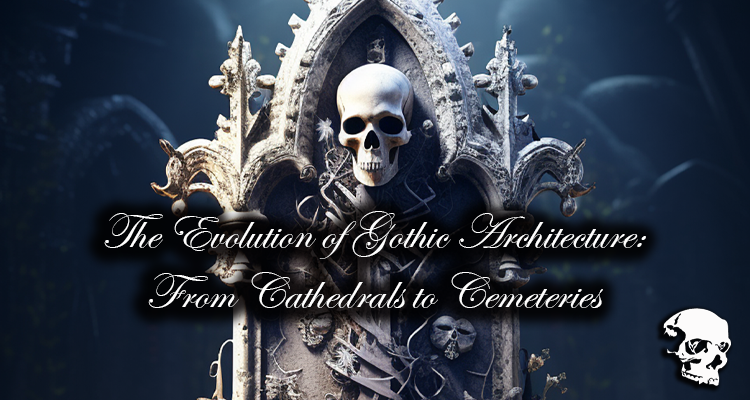Currently Empty: $0.00

The Evolution of Gothic Architecture:From Cathedrals to Cemeteries
Once upon a time, in the bygone epochs of Europe’s Middle Ages, an
architectural revolution was born. A style that continues to stir the soul, awe
the mind, and cast haunting silhouettes against the sky: Gothic architecture.
A style indelibly inked into the parchment of history, it’s a living testament
to the grandeur and complexity of human creativity. From the formidable
cathedrals, with their lofty spires reaching heavenwards, to the quiet,
brooding cemeteries, Gothic architecture weaves a fascinating narrative of
evolution and adaptation.
Ecclesia, the Celestial Vessel
The genesis of Gothic architecture can be traced back to the 12th-century
ecclesiastical structures of France, the most notable being the grand dame
of Paris, Notre-Dame Cathedral. Gothic architecture broke free from the
architectural shackles of the Romanesque style, showcasing an appetite for
verticality, light, and ornate detail.
Its defining traits—ribbed vaults, pointed arches, and flying buttresses—
created an aesthetic of grandeur and height. The flying buttresses allowed for
larger windows, which were filled with radiant stained glass, drenching the
interiors in kaleidoscopic hues, turning these holy spaces into divine vessels
of celestial light.
Gothic Secularization: From Sacred to Profane
Despite its divine origins, Gothic architecture refused to remain confined within ecclesiastical walls. It was as if the ornate vaults, lofty spires, and radiant stained-glass windows yearned to breathe the air beyond the confines of their hallowed birthplaces. The aesthetic appeal and the structural innovations of the style bled into the veins of secular architecture, stitching a rich tapestry of intricacy and grandeur into the very fabric of medieval society.
From the 14th century onwards, the Gothic wave spread across the continent with an infectious zeal. It found its way into the universities, becoming the bedrock upon which centers of learning and wisdom were built. Take a leisurely stroll through the venerable corridors of the University of Oxford or the University of Paris, and you’ll witness the echoes of the Gothic spirit whispering tales of erudition and enlightenment.
Town halls and guildhalls were no exception to the allure of Gothic architecture. In the bustling city centers, these civic buildings stood as titans of power and authority. Their Gothic features, adorned with decorative traceries, carved statues, and magnificent façades, imbued them with an air of prestige and significance. The Town Hall of Leuven in Belgium, resplendent with its detailed ornamentation and soaring towers, exemplifies the Gothic transition into the domain of civic pride.
And then came the dwellings of the emergent urban elites—individuals of affluence and influence who sought to stamp their mark on society. For them, the grandeur of the Gothic style was simply irresistible. Timber-framed houses in England stood proudly with their characteristic steep gabled roofs and intricate wooden carvings. Across the English Channel, the stone-built hotels particuliers in France flaunted their Gothic heritage with resolute elegance. These residential architectures served not only as comfortable living quarters but also as tangible assertions of wealth, power, and prestige.
The Eternity of Gothic: In Death as in Life
The final chapter in the evolutionary tale of Gothic architecture resides in a place of serene tranquility and quiet solemnit —the cemetery. An aesthetic fit for both the realms of the living and the dead, the Gothic style found a fitting embrace within these silent cities. It resonated deeply with themes of mortality, eternity, and the sublime, etching an evocative silhouette against the backdrop of the eternal skies.
Cemeteries like the Père Lachaise in Paris or the Highgate Cemetery in London bear the intimate whispers of this enduring love affair. These burial grounds, carpeted by a kaleidoscope of memories and emotions, imbue the Gothic style with a spectral elegance that infuses the atmosphere with a sense of serene melancholy and romantic allure.
Tombs within these cemeteries are crowned with Gothic pinnacles that reach out towards the heavens, as though striving to bridge the chasm between the earthly and the divine. Their ornate detailing and commanding presence bear the hallmark of the grand cathedrals from which they drew their inspiration, reflecting the solemn grandeur of life’s final journey.
Mausoleums, on the other hand, are adorned with tracery windows, a defining feature of the Gothic aesthetic. Their delicate designs, carved into the stony faces of these timeless structures, echo the beauty and intricacy of cathedral windows. They are like veiled eyes, peeking into eternity, adding
an element of haunting beauty to these cities of the dead.
The journey of Gothic architecture from the sacred confines of cathedrals to the quiet expanse of cemeteries is a fascinating narrative of adaptability and resilience. It reflects the myriad ways in which an artistic style can pervade the canvas of society, leaving indelible marks on the cultural, spiritual, and even mortal landscapes.
As we marvel at the spectral elegance of Gothic structures today, standing resolute against the passing of centuries, we are reminded of the style’s longevity and its eternal resonance with the human soul. From the cathedral spires that point heavenward to the tombstones that mark our final resting place, Gothic architecture stands as a profound testament to our ageless quest for beauty, meaning, and transcendence. It’s a style that has journeyed through epochs and echoes with the collective memory of our shared human experience, weaving together the threads of life, death, and beyond.
Are you enjoying this article or our site? Love of Gothic and the Dark Matters & Mischief magazine are run by dedicated volunteers, and we rely on crowdfunding to cover our expenses. Your support is crucial to keep us going! Consider becoming a paying member of our Patreon or purchasing something from our shop to help us continue providing content and community support. Thank you for your support!
